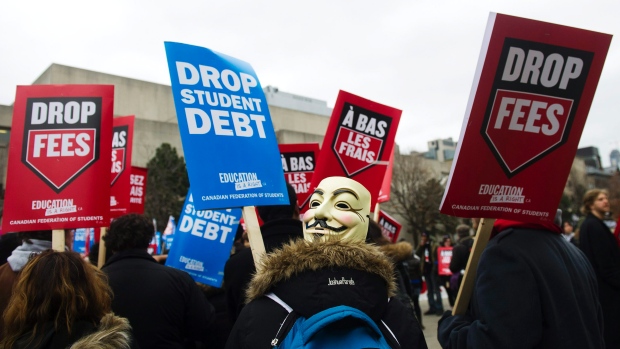Joel Leckie:
We all know the impact of rising tuition costs and the ongoing debate about government subsidies for tuition. But one of the things that hasn’t really been expressed as a possible solution is revising the process of student loans. There are a ton of scholarships and bursaries available but they can be a pain to sift through. And some people cannot afford to go to school without working full time and even that won’t always pay all of the bills.
Canada is more fortunate than the United States. Here, a lot of tuition costs, for local students at least, are subsidized. However, continuing to do this can place a huge burden on the government when it comes to students who go in for a partial program they don’t complete. There is no overall gain, only costs. So what about having a student loan system with an enhanced loan forgiveness program?
It would work like this: prospective students apply, are accepted and then go to the loans department and apply for a student loan. The loan is approved and the student is able to pay for school bills, rent and a little extra for necessities, such as food. This frees a student from the burden of needing a full-time job while taking full-time classes, a situation that can be unreasonably stressful.
As with loans now, there is no principle payment or accrued interest while the student is in school or registered to return to school. He or she will still need to work over the summer to earn enough income for summer rent and expenses but won’t need to come up with thousands of dollars again for the fall. That loan has already been approved and, with the new term, new amounts are added to the existing loan.
Under this plan, the difference comes when students finish their program. After a year, two years, four years or however long it takes the program to be completed, the student will submit a completed program report to the loans office, proving they achieved what they set out to accomplish. Then, for the next year or so, they provide a progress report. This can be as simple as type of work they are doing and where they are living. When the job is in the appropriate field and the work is relatively local (i.e. in Canada), then it shows they are stimulating the economy. A percentage of the loan, based on the industry, will then instantly be forgiven.
Costs $20,000 to go to business school for four years? Since you work in local business you now only owe $5,000 on your loan. Thank you for contributing. The catch? If you drop out or move out of the field, that education is virtually useless to the government and the full amount owing remains.
Connor O’Donovan:
I’ll be the first to admit that the concept of free college tuition poses a lot of questions for our conservative society. Many are being brought up for public discussion now that the Ontario government has announced plans to provide free tuition to students whose parents make less than $50,000 a year.
Is this threshold fair to families and individuals making just over the $50,000 mark? What about to those working extra jobs or overtime to make their financial ends meet? And who is going to pay for it? Surely taxes will be raised somewhere but why should the burden fall upon those who worked hard to pay for their own education? Will these tax dollars go to waste on students who aren’t truly committed to their studies? And what would be deemed legitimate as post-secondary education?
Answering these questions suitably would surely require a great deal of thought, creativity, trial and error. Here’s the justification for the effort – education is a human right. A proper education is necessary for survival and always has been. Once upon a time, education might have involved learning how to properly hunt bison. In today’s society, the lessons are different but the goal of providing for oneself remains the same.
Education – including institutions of learning utilized beyond grade school – is the foundation upon which all of the world’s innovations are built. Advancements in the fields of medicine, engineering, ethics, politics and the arts are all owed to the education systems of their innovators. The homepage of Google Scholar is bannered with the phrase “Stand on the shoulders of giants.” Malala Yousafzai said “With guns you can kill terrorists, with education you can kill terrorism.” Education’s importance falls only slightly behind that of the air we breathe.
The first and biggest barrier to free college tuition is probably cost (obviously it can’t technically be “free”). There are numerous European countries that already offer free tuition, countries with tax rates not that much higher than our own. Perhaps the costs could be subsidized by a special tax rate applied to those who have received free tuition. The tax could apply only if a student graduates and finds employment in his or her respective field.
The danger of wasted resources lurks within the high percentage of students who drop out during or after their first year of studies. This number could potentially be exacerbated by removing the motivation of expense incurred by tuition cost. I’ve heard some suggest making only the first year of education free. Maybe the first year is the only one that students should have to pay for. It would significantly lower overall post-secondary cost and provide incentive for students to suc-ceed in their senior years.
I can foresee an argument over whether or not all faculties of education should be offered at no cost. Keeping enrolment limits low could prevent the supersaturation of particular skill markets and promote the development of more adaptable skill sets through increased competition.
As far as who should qualify for free college tuition, I agree with a recent Toronto Sun columnist’s argument that we needn’t create another way for income levels to divide us. You might remember this quote from your high school Social Studies class, “Education is the great equalizer.” Equal opportunity should available to all.
Image information: Students protest Ontario tuition costs at the University of Toronto campus in Toronto on Wednesday, Feb. 1, 2012. (Nathan Denette/THE CANADIAN PRESS)






